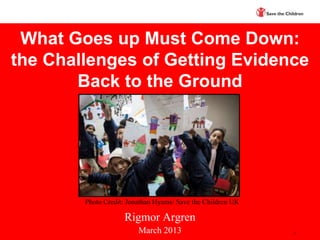
Getting Evidence Back to Improve Humanitarian Response
- 1. What Goes up Must Come Down: the Challenges of Getting Evidence Back to the Ground Photo Credit: Jonathan Hyams/ Save the Children UK Rigmor Argren March 2013 1
- 2. Save the Children International 29 Save the Children Members SCI in 47 Countries (6 remaining) Development and Humanitarian Programmes Photo Credit: Rigmor Argren/ Save the Children, Bonga, Ethiopia 2006 2
- 3. Save the Children’s Humanitarian Responses 26 responses in 30 countries. (Feb 2013) •Education in Emergencies • Health and Nutrition • WASH • Food Security and Livelihoods • Shelter • Child Protection in Emergencies 3
- 4. “Getting Evidence Back to the Ground” Photo credit: Save the Children ”Evidence”: 1. Monitoring 2. Real Time Reviews 3. Evaluation of Humanitarian Action ”Back to the Ground”: Actions to Improve Humanitarian Response 4
- 5. Real Time Reviews Real Time Reveiws: •In Real Time (8-10 weeks) •Mandatory for large scale responses •Internal •facilitatory approach 5
- 6. ALNAP Evaluation Frame Applied Capacity Area 1: Increased demand for evaluation information Capacity Area 2: Purpose and Strategic timing Photo Credit: Nyani Quarmyne/ Save the Children Capacity Area 3: Focus on what to evaluate Capacity Area 4: Adequate resourcing 6
- 7. Evidence for Learnings Why We Do What We Do What We What We What We Do Do Get Resistance Argyris & Schön (1978) 7
- 8. Evidence for Single Loop Learning ”Evidence”: 1. Monitoring 2. Real Time Reviews 3. Evaluation of Humanitarian Action Photo Credit: Save the Children 8
- 9. RTR Evidence for Single Loop Learning • Strengthen sector integration • Improved interaction with local communities • Re-enforcing security protocols • Increased visibility Photo Credit: Colin Crowley/Save the Children 9
- 10. RTR Evidence for Double Loop •Changed approach to implementation •Re-inforced leadership •Creating the Strategic Momentum Photo Credit: Helene Caux/ UNHCR, 2004 10
- 11. Challenges with RTR Evidence •Short Lived Data •Destill Generic and Transferable Learnings •Evidence from External Sources •Decision Making •Needs follow-up Photo Credit: Save the Children 11
- 12. Opportunities •Connect available Evidence •Seek Trends, through Longitudinal Observations •Leverage the Dual Mandate •RTRs can be prepared/planned •RTRs can relate to Photo credit: Rigmor Argren/ Save the Children assessments 12
